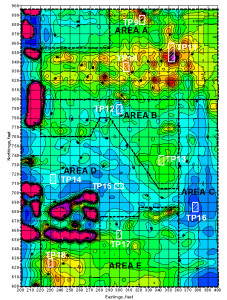Challenge
A Phase I Environmental Site Assessment for a flat, gravel-covered, 1.3 acre parcel in an urban site in Indianapolis, Indiana indicated that it had been covered with multiple building structures over most of its 100 year use. Facilities had included warehouses, a bar, a restaurant, a baker, and a dentist. However, no records of building demolition had been found during the assessment, although it was suspected that debris from the structure razing had been disposed of on-site. Because of the desire to develop the property, the Phase I ESA recommended a subsurface investigation be conducted to identify suspected impacted and hazardous materials that may have been buried on the site. Due to the expected demolition debris, the use of test pits to uncover areas of concern was recommended. However, since no evidence existed as to where the pits should be located, Mundell was asked to perform a geophysical survey to guide the selection of test pit locations.
Action
To accomplish the study objectives, Mundell personnel completed a multi-faceted geophysical survey using electromagnetic and 2-D electrical resistivity equipment to locate and characterize concealed metallic objects such as underground storage tanks, steel drums, utilities and metallic debris, and to map variations in different fill materials.
Results
The results indicated significant metallic objects and five distinct areas of similar subsurface fill materials (Areas A through E in the above figure). Using the geophysical results, Mundell recommended the location of eighteen (18) test pits for determining the expected character of the buried materials. The excavations uncovered building and construction debris, concrete slabs, bricks, wood, sheet metal, scrap metal, and slag and ash (see to the left). No obvious chemically-impacted fill materials of concern or asbestos-containing materials were encountered. Using the quantities of materials estimated from the geophysical survey and the types of materials found at the site within the test pits, a cost estimate for developing the property ranged from about $430,000 to $600,000. This included the costs of excavation, transportation and landfill disposal of materials.




